Free PDF of CBSE Physics Multiple Choice Questions for Class 12 with Answers Chapter 2 Electrostatic Potential and Capacitance. Physics MCQs for Class 12 Chapter Wise with Answers PDF was Prepared Based on Latest Exam Pattern. Students can solve NCERT Class 12 Physics Electrostatic Potential and Capacitance MCQs Pdf with Answers to know their preparation level.
1 . The electric potential inside a conducting sphere
- Increases from centre to surface decreases
- from centre to surface
- Remains constant from centre to surface
- Is zero at every point inside
Answer/Explanation
1 . (3)
Electric potential inside a conductor is constant and it is equal to that in the surface of the conductor.
2. One volt is equivalent to
- newton/second
- newton/coulomb
- joule/coulomb
- joule/second
Answer/Explanation
2. (3)
V = W/Q
3. The potential at a point due to a charge of 4 x 10-7 C located 10 cm away is?
- 3.6 x 105 V
- 3.6 x 104 V
- 4.5 x 104 V
- 4.5 x 105 V
Answer/Explanation
3. (2)
V = q/(4π𝛜or) = (9 x 109 x 4 x 10-7) / 0.1 = 3.6 x 104 V
4. The electric potential at a point in free space due to a 1 charge Q coulomb is Q x 1011 V. The electric field at that point is
- 12π𝛜oQ x 1022 Vm-1
- 4π𝛜oQ x 1020 Vm-1
- 12π𝛜oQ x 1020 Vm-1
- 4π𝛜oQ x 1022 Vm-1
Answer/Explanation
4. (4)
V = Q/(4π𝛜or) = Q x 1011
4π𝛜or = 10-11
E = (Q x 4π 𝛜o) / (4π 𝛜o r)2 = (Q x 4π 𝛜o) / (10-11)2 = 4π 𝛜oQ x 1022 Vm-1
5. An electric dipole is placed at the centre of a hollow conducting sphere. Which of the following is correct?
- Electric field is zero at every point of the sphere
- Electric field is not zero anywhere on the sphere
- The flux of electric field is not zero through the sphere
- None of these
Answer/Explanation
5. (2)
When electric field is held in the sphere, electric field is not zero anywhere on the sphere. However, net electric flux through the sphere is zero.
6. Figure shows the field lines of a positive point charge. The work done by the field in moving a small positive charge from Q to P is
- zero
- positive
- negative
- data insufficient
Answer/Explanation
6. (3)
In moving a small positive charge from Q to P, work has to be done by an external agency against the electric field. Therefore, work done by the electric field is negative.
7. The value of electric potential at any point due to any electric dipole is

- (a)
- (b)
- (c)
- (d)
Answer/Explanation
7. (4)
V = (pcosΘ) / (4π𝛜or2)
8. As shown in the figure, charges +q and -q are placed at the vertices B and C of an isosceles triangle. The potential at the vertex A is:
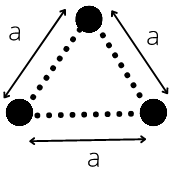

- (a)
- (b)
- (c)
- (d)
Answer/Explanation
8. (4)
Potential at A = Potential due to +q charge + Potential due to -q charge
q / 4π𝛜o√(a2) – q / 4π𝛜o√(a2) = 0
9. Four charges each equal to q are placed at the corners of a square of side l. The electric potential at the centre of the square is

- (a)
- (b)
- (c)
- (d)
Answer/Explanation
9. (3)
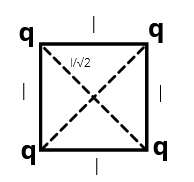
Electric potential due to each charge at the centre of the square is √2q / 4π𝛜ol
Total potential will be = 4 x (√2q / 4π𝛜ol) = √2q / π𝛜ol
10. Can two equipotential surfaces intersect each other?
- Yes
- No
- Sometimes
- Only when surfaces intersect at 900
Answer/Explanation
10. (2)
Intersection of two equipotential surfaces at a point will give two directions of electric field intensity at that point, which is not possible.
11. If a unit positive charge is taken from one point to another over an equipotential surface, then
- Work is done on the charge
- Work is done by the charge
- Work done is constant
- No work is done
Answer/Explanation
11. (4)
On the equipotential surface the electric field is normal to the charged surface. So, no work will be done.
12. A hollow conducting sphere is placed in an electric field produced by a point charge placed at P as shown in figure. Let VA, VB, VC be the potentials at points A, B and C respectively. Then
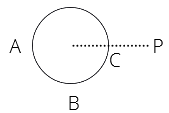
- VB
- VB > VC
- VA > VB
- VA = VB
Answer/Explanation
12. (4)
Conducting surface behaves as an equipotential surface.
13. A test charge is moved from lower potential point a higher potential point. The potential energy of the charge will
- remains the same
- increase
- decrease
- becomes zero
Answer/Explanation
13. (2)
By using U = QV
Q = +1, U = V
At higher potential, potential energy will be high and at lower potential, lower energy will be present
14. The potential energy of a system of two charges is negative when
- both the charges are positive
- both the charges are negative
- one charge is positive and other is negative
- both the charges are separated by infinite distance
Answer/Explanation
14. (3)
The potential energy is negative whenever there is attraction. Since a positive and negative charge attract each other, their energy is negative. When both the charges are separated by infinite distance, they do not attract each other and their energy is zero .
15. An electric dipole of moment P is placed normal to the lines of force of electric field intensity E, then the work done in deflecting it through an angle of 180° is
- pE
- 2pE
- -2pE
- zero
Answer/Explanation
15. (4)
W = pE ( cos 90o-cos 270o)
16. When one electron is taken towards the other electron, then the electric potential energy of system
- decreases
- increases
- remains unchanged
- becomes zero
Answer/Explanation
16. (2)
Potential energy of the system U = ((-e) x (-e)) / 4π𝛜or
17. Q amount of electric charge is present on the surface 2 of a sphere having radius R. Then electrical potential energy of this system is
- kQ/R
- kQ2/R
- kQ2/2R
- kQ2/2R2
Answer/Explanation
17. (3)

18. The electrostatic potential energy of a charge of 5C at a point in the electrostatic field is 50 J. The potential at that point is
- 0.1 V
- 5 V
- 10 v
- 250V
Answer/Explanation
18. (3)
Potential = Potential energy / test charge
19. Two charges of equal magnitude ‘q’ are placed in air at a distance ‘2a’ apart and third charge ‘-2q’ is placed at midpoint. The potential energy of the system is: (𝛜o = permittivity of free space)
- -q2/8π𝛜oa
- -3q2/8π𝛜oa
- -5q2/8π𝛜oa
- -7q2/8π𝛜oa
Answer/Explanation
19. (4)
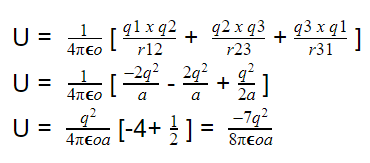
20. A conductor which can be given almost d charge is
- copper
- air
- gold
- earth
Answer/Explanation
20. (4)
Earth is conductor which can be given almost unlimited charge.
21. If a conductor has a potential zero and there are o charges anywhere else outside, then
- there must be charges on the surface or inside itself
- cannot be any charge in the body of conductor
- there must be charges only on the surface
- both 1 and 2 are correct
Answer/Explanation
21. (3)
If a conductor has a non zero potential and there are no charges anywhere else outside, then there must be charges on the surface of the conductor or inside the conductor. There can not be any charge in the body of the conductor.
22. There are two metallic spheres of same radii but one is solid and the other is hollow, then
- solid sphere can be given more charge
- hollow sphere can be given more charge
- they can be charged equally (maximum)
- none of the above
Answer/Explanation
22. (3)
In case of metallic sphere either solid or hollow, the charge will reside on the surface of the sphere. Since both spheres have same surface area, they can hold amount of maximum charge .
23. A conductor with a positive charge:
- is always at positive potential
- is always at zero potential
- is always at negative potential
- may be at positive, zero or negative potential
Answer/Explanation
23. (4)
The conductor may be a positive, zero or negative potential. It is according to the way one defines the zero potential .
24. When air is replaced by a dielectric medium of constant K, the maximum force of attraction between two charges separated by a distance
- increases K times
- remains unchanged
- decreases K times
- increases K-l times
Answer/Explanation
24. (3)
Fm = Fo/k
25. Dielectric constant of a medium is also known as
- relative permeability
- permeability
- permittivity
- relative permittivity
Answer/Explanation
25. (4)
k = εr = ε/εo = Relative permitivity
26. On decreasing the distance between the plates Of a parallel plate capacitor, its capacitance
- remains unaffected
- decreases
- first increases then decreases
- increases
Answer/Explanation
26. (4)
C = εoKA / d, capacitance is inversely proportional to the distance.
27. Energy is stored in a capacitor in the form of
- magnetic energy
- light energy
- heat energy
- electrostatic energy
Answer/Explanation
27. (4)
Energy stored in the capacitor is called electrostatic energy.
28. If in a parallel plate capacitor, which is connected to a battery, we fill dielectrics in whole space of its plates, then which of the following increases?
- Q and V
- V and E
- E and C
- Q and C
Answer/Explanation
28. (4)
C = εoKA/d and q = CV
29. In a parallel plate capacitor, the capacity increases if
- area of the plate is decreased
- distance between the plates increases
- area of the plate is increased
- dielectric constant decreases
Answer/Explanation
29. (3)
Capacitance is directly proportional to the area.
30. The energy stored in a condenser of capacity C which has been raised to a potential V is given by
- -CV
- -CV2
- CV
- CV2
Answer/Explanation
30. (2)

31. The work done in placing a charge of 8 x 10-18 C on a condenser of capacity 100µF is
- 3.2 10-26J
- 3.2 10-31J
- 3.2 10-32J
- 4 x 10-26J
Answer/Explanation
31. (2)
W = q2 / 2C = ( 8 x 10-18 )2 / 2 x 100 x 10-6 = 3.2 x 10-31 J
32. A parallel plate capacitor has two square plates with equal and opposite charges. The surface charge densities on the plates are +σ and -σ respectively. In the region between the plates the magnitude of the electric field is
- σ/2𝛜o
- σ/𝛜o
- 0
- None of these
Answer/Explanation
32. (2)
σ/𝛜o
33. In a charged capacitor, the energy resides
- in the positive charges
- in both the positive and negative charges
- in the field between the plates
- around the edges of the capacitor plates
Answer/Explanation
33. (3)
Energy resides in the field between the plates in a charged capacitor.
34. A parallel plate air capacitor hag capacitance 100 µF. The plates are at a distance d apart. If a slab of thickness t (t < d) and dielectric constant 5 introduced between the parallel plates, then the capacitance will be
- 30 µC
- 100 µC
- 200 µC
- 500 µC
Answer/Explanation
34. (3)
Capacitance will increase but not 5 times as the dielectric is not completely filled.
35. A parallel plate capacitor is connected across a 2 V battery and charged. The battery is then disconnected and a glass slab is introduced between plates. Which of the following pairs of quantities decreases?
- Charge and potential difference.
- Potential difference and energy stored.
- Energy stored and capacitance.
- Capacitance and charge.
Answer/Explanation
35. (2)
When battery is disconnected, charge remains constant. On introducing glass slab, capacitance increases. Potential difference and energy stored decreases.
36. An example of an equipotential surface in earth is
- A line passing through the centre of the earth connecting two points along the diameter
- A plane that passes through the circular section of the hemisphere of the earth
- A spherical surface at a distance of 1 km from the surface of the earth with its centre at the centre of earth
- a plane on the surface of the earth, which is a tangent to the earth
Answer/Explanation
36. (3)
A line passing through the centre of the earth connecting two points along the diameter
37. Work done in moving a substance through an equipotential surface is
- positive
- negative
- zero
- depends on the direction of the field
Answer/Explanation
37. (3)
Work done in moving a charge over an equipotential surface is always zero.
38. Two fixed charges separated by a distance d experience a force F. A dielectric medium of thickness d/4 and dielectric constant 4 is introduces in the space between them. Find the new force acting between the charges.
- F / 4
- F / 3
- F
- 16F / 25
Answer/Explanation
38. (1)
39. Water is not used as a dielectric between the plates of capacitor because
- dielectric constant is very low
- dielectric strength is very low
- dielectric constant is very high
- dielectric strength is very high
Answer/Explanation
39. (2)
Water is not used as dielectric between the plates of the capacitor as it has a large dielectric constant but a quite low amount of dielectric strength, which is why it is not used inside a capacitor.
40. 64 small drops of mercury coalesce to form a big drop. The ratio of the surface charge density of each small drop with that of big drop is
- 4 : 1
- 1 : 4
- 1 : 64
- 64 : 1
Answer/Explanation
40. (2)
1 : 4
41. Electric charge given to the hollow conductor resides
- on the outer surface
- at the centre
- on the inner surface
- uniformly on the outer as well as on the inner surface
Answer/Explanation
41. (1)
In all conductors, charges reside on the surface.
42. A man stands inside a large metal charged sphere. Will his hair stand on end?
- yes
- no
- data insufficient
- no guess
Answer/Explanation
42. (2)
A metallic sphere means a conductors and as the electric field is zero inside a conductor, the hairs won’t stand up of the man.
43. Stainless steel pans are usually provided with copper bottoms. The reason behind this is
- Copper bottoms makes the pan more durable
- Such pans looks colourful
- Copper is easier to clean
- Copper is a better conductor of heat than steel
Answer/Explanation
43. (4)
Cooper is a better conductor of heat than stainless steel.
44. The radii of two metallic spheres are 5 cm and 10 cm and both carry and equal charge of 75µC. If the two spheres are shorted then the charge will be transferred
- 25µC from smaller to bigger
- 25µC from bigger to smaller
- 50µC from smaller to bigger
- 50µC from bigger to smaller
Answer/Explanation
44. (1)
45. A system has been given which has 3 point charges q, 2q and xq which are separated by equal finite distance so that electric potential energy of the system is zero, then the value of x is
- -2/3
- -1/3
- 2/3
- 3/2
Answer/Explanation
45. (1)
Assertion and Reasoning MCQ
Codes
(a) Both A and R are true and R is the correct explanation of A
(b) Both A and R are true and but R is not a correct explanation of A
(c) A is true but R is false
(d) A is false, but R is true
1 . Assertion (A) Work done in moving a charge between any two points in an electric field is dependent of the path followed by the charge, between these points.
Reason (R) Electrostatic force is a non-conservative force
Answer/Explanation
1 . (d)
Electrostatic force is a conservative force.
2. Assertion (A) The electric potential at any point on the equitorial plane of a dipole is non-zero.
Reason (R) The work done in bringing a unit positive charge from infinity to a point in equitorial plane is not equal for the two charges of the dipole.
Answer/Explanation
2. (d)
The electric potential at any point on equatorial plane of a dipole is zero.
3. Assertion (A) For a non-uniformly charged thin circular ring with net charge is zero, the electric field at any point on axis of the ring is zero.
Reason (R) For a non-uniformly charged thin circular ring with net charge zero, the electric potential at each point on axis of the ring is zero.
Answer/Explanation
3. (d)
For a non uniformly charged thin circular ring with net zero charge, electric potential at each point on its axis is zero. Hence electric field at each point on its axis must be perpendicular to the axis.
4. Assertion (A) For a point charge concentric spheres centred at a location of the charge are equipotential surface.
Reason (R) An equipotential surface is a surface over which potential has constant value.
Answer/Explanation
4. (b)
An equipotential surface is a surface over which potential is same.
5. Assertion (A) Electric potential and electric potential energy are different quantities
Reason (R) For a system of positive test charge and point charge electric potential energy = electric potential
Answer/Explanation
5. (c)
Potential and potential energy at different quantities and cannot be equated.
6. Assertion (A) Surface of a symmetrical conductor can be treated as equipotential surface
Reason (R) Charge can easily flow in a conductor.
Answer/Explanation
6. (a)
Potential is constant on surface of a sphere so it behaves as an equipotential surface.
7. Assertion (A) Two adjacent conductors of unequal dimensions, carrying the same positive charge have a potential difference between them.
Reason (R) The potential of a conductor depends upon the charge given to it.
Answer/Explanation
7. (b)
Let us considered to spherical shells of radii ‘a’ and ‘b’ which are having the same positive charge Q. Hence, the potential on the surface of each conductor will be,
V1 = kQ/a V2 = kQ/b
As a ≠ b, V1 ≠ V2 and there will be a potential difference too.
8. Assertion (A) When a dielectric slab is gradually inserted between the plates of an isolated parallel plate capacitor, the energy of the system decreases.
Reason (R) The force between the plates decreases.
Answer/Explanation
8. (c)
C’ = KC and U’ = q2/2C’ = q2/2KC
9. Assertion (A) Polar molecules have temporary dipole moment.
Reason (R) In polar molecule, the centres of positive and negative charges conincide even there is no external field.
Answer/Explanation
9. (d)
The molecules of a substance may be polar or non-polar. In a polar molecule, the centres of positive and negative charges coincide. This molecule has no permanent dipole moment. A polar molecule has its centres of posiitve and negative charges separated, even when there is no electric field. Such molecules have permanent dipole moment.
10. Assertion (A) In the Van de Graaff generator, the process of spraying the charge is called electron discharge.
Reason (R) Van de Graaff generator produces high voltage and high current.
Answer/Explanation
10. (d)
In Van de Graaff generator, the process of spraying the charge is called corona discharge. Van de Graaff generator produces high voltage and low current.
Electrostatic Potential And Capacitance MCQ Chapter 2
Electrostatic potential is the amount of work done to move a charge from a reference point to a specific point.
Below are some of the very important NCERT Electrostatic Potential and Capacitance MCQ Class 12 Physics Chapter 2 with answers. These Electrostatic Potential and Capacitance MCQ have been prepared by expert teachers and subject experts based on the latest syllabus and pattern of CBSE Term 1 examination.
Electrostatic Potential and Capacitance Class 12 Physics MCQs
1. A positively charged particle is released from rest in an uniform electric field. The electric potential energy of the charge [NCERT Exemplar]
(a) remains a constant because the electric field is uniform.
(b) increases because the charge moves along the electric field.
(c) decreases because the charge moves along the electric field.
(d) decreases because the charge moves opposite to the electric field.
Answer/Explanation
Answer: c
Explaination:
(c) The positively charged particle experiences electrostatic force along the direction of electric field, hence moves in the direction of electric field. Electric potential decreases in the direction of electric field. Thus, positive work is done by the electric field on the charge.
We = -ΔU = -qΔV=q(Vin – Vf)
Hence electrostatic potential energy of the positive charge decreases.
2. Figures show some equipotential lines distributed in space. A charged object is moved from point A to point B. [NCERT Exemplar]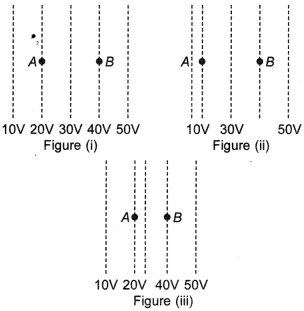
(a) The work done in Fig. (i) is the greatest.
(b) The work done in Fig. (ii) is least.
(c) The work done is the same in Fig. (i), Fig.(ii) and Fig. (iii).
(d) The work done in Fig. (iii) is greater than Fig. (ii) but equal to that in Fig. (i).
Answer/Explanation
Answer: c
Explaination:
(c) The work done by the electric field on the charge will be negative.
Welectrical = -ΔU = – qΔV— q( Vinitial – Vfinal) Here initial and final potentials are same in all three cases and the same charge is moved, so work done is same in all three cases.
3. Equipotentials at a great distance from a collection of charges whose total sum is not zero are approximately [NCERT Exemplar]
(a) spheres
(b) planes
(c) paraboloids
(d) ellipsoids
Answer/Explanation
Answer: a
Explaination:
(a) The collection of charges at great distance is considered as a single point charge. The equipotential surfaces due to a point charge are spherical.
4. Two small spheres each carrying a charge q are placed r metre apart. If one of the spheres is taken around the other one in a circular path of radius r, the work done will be equal to
(a) force between them × r
(b) force between them × 2πr
(c) force between them/2πr
(d) zero
Answer/Explanation
Answer: d
Explaination: (d) The force is perpendicular to the displacement.
5. The electric potential V at any point O (x, y, z all in metres) in space is given by V = 4x² volt. The electric field at the point (1 m, 0, 2 m) in volt/metre is
(a) 8 along negative x-axis
(b) 8 along positive x-axis
(c) 16 along negative x-axis
(d) 16 along positive z-axis
Answer/Explanation
Answer: a
Explaination: (a) The electric field E = \(\frac{-dV}{dx}\) = -8x V/m
6. If a unit positive charge is taken from one point to another over an equipotential surface, then
(a) work is done on the charge.
(b) work is done by the charge.
(c) work done is constant.
(d) no work is done.
Answer/Explanation
Answer: d
Explaination:
(d) On the equipotential surface, electric field is normal to the charged surface (where potential exists) so that no work will be done.
7. A hollow metal sphere of radius 5 cm is charged so that the potential on its surface is 10 V. The potential at the centre of the sphere is
(a) 0 V
(b) 10 V
(c) Same as at point 5 cm away from the surface
(d) Same as at point 25 cm away from the surface
Answer/Explanation
Answer: b
Explaination: (b) Since potential inside the hollow sphere is same as that on the surface.
8. The electrostatic force between the metal plates of an isolated parallel plate capacitor C having a charge Q and area A, is
(a) proportional to the square root of the distance between the plates.
(b) linearly proportional to the distance between the plates.
(c) independent of the distance between the plates.
(d) inversely proportional to the distance between the plates.
Answer/Explanation
Answer: c
Explaination:
(c) For isolated capacitor Q = Constant,
force between plate = \(\frac{Q^{2}}{2 A \varepsilon_{0}}\).
9. A capacitor is charged by a battery. The battery is removed and another identical uncharged capacitor is connected in parallel. The total electrostatic energy of resulting system
(a) increases by a factor of 4.
(b) decreases by a factor of 2.
(c) remains the same.
(d) increases by a factor of 2.
Answer/Explanation
Answer: b
Explaination: (b) Using, Vc = \(\frac{V}{2}\), U = \(\frac{1}{2}\)CV².
10. A conductor with a positive charge
(a) is always at +ve potential.
(b) is always at zero potential.
(c) is always at negative potential.
(d) may be at +ve, zero or -ve potential.
Answer/Explanation
Answer: d
Explaination:
(d) May be at positive, zero or negative potential, it is according to the way one defines the zero potential.
11 v Figure shows the electric lines of force emerging from a charged body. If the electric field at A and B are EA and EB respectively and if the displacement between A and B is r then
(a) EA > EB
(b) EA < EB
(c) EA = EB/r
(d) EA = EB /r²
Answer/Explanation
Answer: a
Explaination: (a) In non-uniform electric field, intensity is more, where the lines are more denser.
12. Which of the following options are correct? If a conductor has a potential V 4- 0 and there are no charges anywhere else outside, then [NCERT Exemplar]
(a) there must not be charges on the surface or inside itself.
(b) there cannot be any charge in the body of the conductor.
(c) there must be charges only on the surface.
(d) there must be charges inside the surface.
Answer/Explanation
Answer: b
Explaination:
(b) The charge resides on the outer surface of a closed charged conductor. Hence there cannot be any charge in the body of the conductor. Hence option (b) is correct.
13. Which of the following options is correct? In a region of constant potential [NCERT Exemplar]
(a) the electric field is uniform.
(b) the electric field is zero.
(c) there can be charge inside the regiofi.
(d) the electric field shall necessarily change if a charge is placed outside the region.
Answer/Explanation
Answer: b
Explaination:
(b) as E = \(\frac{-dV}{dr}\)
Since, V = constant, \(\frac{-dV}{dr}\) = 0 this implies that electric field intensity E=0. If some charge is present inside the region then electric field cannot be zero at that region, for this V=constant is not valid.
14. 64 drops each having the capacity C and potential V are combined to form a big drop. If the charge on the small drop is q, then the charge on the big drop will be
(a) 2q
(b) 4q
(c) 16q
(d) 64q
Answer/Explanation
Answer: d
Explaination: (d) By using Q = nq or Q = 6Aq
15. The radii of two metallic spheres A and B are r1 and r2 respectively (r1 > r2). They are connected by a thin wire and the system is given a certain charge. The charge will be greater
(a) on the surface of the sphere B.
(b) on the surface of the sphere A.
(c) equal on both.
(d) zero on both.
Answer/Explanation
Answer: b
Explaination:
(b) After connection of wire, potential becomes equal, i.e, Q1/r1 = Q2/r2 or Q1/Q2 = r1/r2 when r1 > r2, then Q1 > Q2.
16. A parallel plate condenser is connected with the terminals of a battery. The distance between the plates is 6mm. If a glass plate (dielectric constant K = 9) of 4.5 mm is introduced between them, then the capacity will become
(a) 2 times.
(b) the same.
(c) 3 times.
(d) 4 times.
Answer/Explanation
Answer:
Explaination:
17. Three charges Q, +q and +q are placed at the vertices of an equilateral triangle of side l as shown in the figure. If the net electrostatic energy of the system is zero, then Q is equal to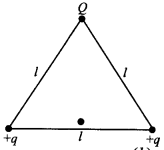
(a) -q
(b) +q
(c) zero
(d) –\(\frac{q}{2}\)
Answer/Explanation
Answer:
Explaination:
18. Two metal plates form a parallel plate capacitor. The distance between the plates is d. A metal sheet of thickness \(\frac{d}{2}\) and of the same area is introduced between the plates.
What is the ratio of the capacitance in the two cases?
(a) 2 : 1
(b) 3 : 1
(c) 2 : 1
(d) 5 : 1
Answer/Explanation
Answer:
Explaination:
19. Acapacitor of 4 pF is connected as shown in the circuit. The internal resistance of the battery is 0.5 Q. The amount of charge on the capacitor plates will be [NCERT Exemplar]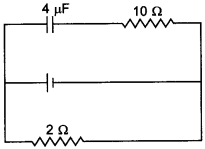
(a) 0
(b) 4
(c) 16 μC
(d) 8 μC
Answer/Explanation
Answer:
Explaination:![]()
20. A capacitor is charged by using a battery which is then disconnected. A dielectric slab
then slipped between the plates, which results in
(a) reduction of charge on the plates and increase of potential difference across the plates.
(b) increase in the potential difference across the plate, reduction in stored energy, but no change in the charge on the plates.
(c) decrease in the potential difference across the plates, reduction in the stored energy, but no change in the charge on the plates.
(d) none of these
Answer/Explanation
Answer: c
Explaination:
(c) Battery in disconnected so Q will be constant. As
C ∝ K so with introduction of dielec-tric slab, the capacitance will increase and using Q = CV, V will decrease.
Using U = \(\frac{Q²}{2C}\)
21. Which of the following statement is true?
(a) Electrostatic force is a conservative force.
(b) Potential at a point is the work done per unit charge in bringing a charge from any point to infinity.
(c) Electrostatic force is non-conservative
(d) Potential is the productof charge and work.
Answer
Answer: a
22. 1 volt is equivalent to
Answer
Answer: c
23. The work done in bringing a unit positive charge from infinite distance to a point at distance x from a positive charge Q is W. Then the potential at that point is
Answer
Answer: b
24. Consider a uniform electric field in the z-direction. The potential is a constant
(a) for any x for a given z
(b) for any y for a given z
(c) on the x-y plane for a given z
(d) all of these
Answer
Answer: d
25. Equipotential surfaces
(a) are closer in regions of large electric fields compared to regions of lower electric fields.
(b) will be more crowded near sharp edges of a conductor.
(c) will always be equally spaced.
(d) both (a) and (b) are correct.
Answer
Answer: d
26. In a region of constant potential
(a) the electric field is uniform.
(b) the electric field is zero.
(c) there can be no charge inside the region.
(d) both (b) and (c) are correct.
Answer
Answer: d
27. A test charge is moved from lower potential point to a higher potential point. The potential energy of test charge will
(a) remain the same
(b) increase
(c) decrease
(d) become zero
Answer
Answer: c
28. An electric dipole of moment \(\vec{p}\) is placed in a uniform electric field \(\vec{E}\) . Then
(i) the torque on the dipole is \(\vec{p} \times \overrightarrow{\mathrm{E}}\)
(ii) the potential energy of the system is \(\vec{p} . \overrightarrow{\mathrm{E}}\)
(iii) the resultant force on the dipole is zero. Choose the correct option.
(a) (i), (ii) and (iii) are correct
(b) (i) and (iii) are correct and (ii) is wrong
(c) only (i) is correct
(d) (i) and (ii) are correct and (iii) is wrong
Answer
Answer: b
29. If a conductor has a potential V ≠ 0 and there are no charges anywhere else outside, then
(a) there must be charges on the surface or in¬side itself.
(b) there cannot be any charge in the body of the conductor.
(c) there must be charges only on the surface.
(d) both (a) and (b) are correct.
Answer
Answer: c
30. Which of the following statements is false for a perfect conductor?
(a) The surface of the conductor is an equipoten-tial surface.
(b) The electric field just outside the surface of a conductor is perpendicular to the surface.
(c) The charge carried by a conductor is always uniformly distributed over the surface of the conductor.
(d) None of these.
Answer
Answer: d
31. Dielectric constant for a metal is
(a) zero
(b) infinite
(c) 1
(d) 10
Answer
Answer: b
32. When air is replaced by a dielectric medium of constant K, the maximum force of attraction between two charges separated by a distance
(a) increases K times
(b) remains unchanged
(c) decreases K times
(d) increases K-1 times
Answer
Answer: c
33. In a parallel plate capacitor, the capacity increases if
(a) area of the plate is decreased.
(b) distance between the plates increases.
(c) area of the plate is increased.
(d) dielectric constantly decreases.
Answer
Answer: c
34. A parallel plate air capacitor is charged to a potential difference of V volts. After disconnecting the charging battery the distance between the plates of the capacitor is increased using an insulating handle. As a result the potential difference between the plates
(a) increases
(b) decreases
(c) does not change
(d) becomes zero
Answer
Answer: a
35. Two identical capacitors are joined in parallel, charged to a potential V, separated and then connected in series, the positive plate of one is connected to the negative of the other. Which of the following is true?
(a) The charges on the free plated connected to-gether are destroyed.
(b) The energy stored in ths system increases.
(c) The potential difference between the free plates is 2V.
(d) The potential difference remains constant.
Answer
Answer: c
36. A capacitor has some dielectric between its plates, and the capacitor is connected to a dc source. The battery is now disconnected and then the dielectric is removed, then
(a) capacitance will increase.
(b) energy stored will decrease.
(c) electric field will increase.
(d) voltage will decrease.
Answer
Answer: c
37. Two spherical conductors each of capacity C are charged to potential V and -V. These are then connected by means of a fine wire. The loss of energy is
(a) zero
(b) \(\frac{1}{2}\)CV2
(c) CV2
(d) 2 CV2
Answer
Answer: c
38. Work done in taking an electron around a proton in a circular loop is zero. Should the proton necessarily be at the centre of the circular loop?
Answer/Explanation
Answer:
Explaination:
No, because electrostatic force is a conservative force, and work done by a conservative force in a closed path is zero.
39. An uncharged insulated conductor A is brought near a charged insulated conductor B. What happens to charge and potential of 5?
Answer/Explanation
Answer:
Explaination:
Initially the potential of conductor B = V. When an uncharged conductor A is brought near to the conductor B, then the charges will induce on A. If -V1 is the potential due to the negative induced charge at A, and V2 is the potential due to the positive induced charge, then |-V1| > |V2| (as -ve charge is near to B).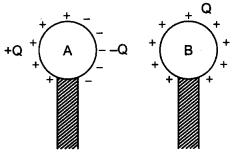
∴ Net potential on B = V – V1 + V2, which is less than V. But charge on B remains same.
40. While defining the electrostatic potential energy, why do we bring a unit positive charge from infinity?
Answer/Explanation
Answer:
Explaination:
Because, at infinity, the electrostatic forces are zero. Therefore, the electrostatic potential energy is also zero.
41. What is the work done in moving a test charge q through a distance of 1 cm along the equatorial axis of an electric dipole?
Answer/Explanation
Answer:
Explaination: Zero.
42. A metal sphere is surrounded by an uncharged concentric thin spherical shell with a charge q and the potential difference between them is V. What is the new potential difference between them, if the shell is now given an additional charge q?
Answer/Explanation
Answer:
Explaination:
The potential difference remains unchanged, because the addition of charge q will increase the potential of both spherical shell and metal sphere by an equal amount.
43. Why is electrostatic potential constant throughout the volume of the conductor and has the same value (as inside) on its surface? [Panchkula 2019, Delhi 2012]
Answer/Explanation
Answer:
Explaination:
As we know that the electrostatic field inside the conductor is zero, therefore no work is done in moving a small test charge, within the conductor and on its surface. We find there is no potential difference between the two points inside or on the surface, which implies the electrostatic potential is constant throughout.
44. A and B are two conducting spheres of the same radius, A being solid and B hollow. Both are charged to the same potential. What will be the relation between the charges on the two spheres?
Answer/Explanation
Answer:
Explaination:
Since the radii of both the spheres are same, and according to the question,
The potential of sphered=potential of sphere B.![]()
45. If a point charge +q is taken first from A to C and then from C to B of a circle drawn with another point charge +q at centre, then along which path more work will be done?
Answer/Explanation
Answer:
Explaination:
Since both the points A and B are equidistant from the electric charge +q.
∴ VA = VB
∴ Work done WA→C = q (VC– VA)
= q(VC – VB) = WB→C
= -WC→B
46. A uniform electric field E exists between two charged plates as shown in figure. What would be the work done in moving a charge q along the closed rectangular path ABCDA?
Answer/Explanation
Answer:
Explaination:
Work done in moving a charge q along a closed rectangular path ABCD is calculated as
W = WAB + WBC + WCD + WDA
W = qE + 0 – qE + 0 = 0 [∵ AB = CD]
47. “For any charge configuration, equipotential surface through a point is normal to the electric field.” Justify. [Delhi 2014]
Answer/Explanation
Answer:
Explaination:
If the electric field is not normal, it will have non-zero component along the surface. In that case, the work done in moving a charge oh the equipotential surface will not be zero.
48. What is the geometrical shape of equipotential surfaces due to a single isolated charge? [Delhi 2013]
Answer/Explanation
Answer:
Explaination: The geometrical shape is spherical.
49. Why is there no work done in moving a charge from one point to another on an equipotential surface? [Foreign 2012]
Answer/Explanation
Answer:
Explaination:
Potential difference between any two points of an equipotential surface is zero. So no work is done in moving a charge from one point to another.
50. Can two equipotential surfaces intersect each other? Justify your answer. [Delhi 2011C]
Answer/Explanation
Answer:
Explaination:
Two equipotential surfaces cannot intersect. The direction of electric field is always perpendicular to the equipotential surface. If they intersect, there will be two directions of the electric field at the point of intersection which is not possible.
51. Why is electrostatic potential energy of a pair of like point charges positive?
Answer/Explanation
Answer:
Explaination: Because the work has to be done against the electrostatic force of repulsion.
52. In the expression W = pE (cos 0O – cos 0j), why is 0Q is taken as n/2 for obtaining expression for the potential energy of electric dipole?
Answer/Explanation
Answer:
Explaination:
When the dipole axis is perpendicular to the electric field, i.e. θO = π/2, the work done against the external electric field \(\vec{E}\) in bringing the charges +q and -q is equal and opposite, and cancel out, i.e. q[V(r1) – V(r2)] = 0. Therefore, initial potential energy is zero.
53. Why should electrostatic field be zero inside a conductor? [Delhi 2012]
Answer/Explanation
Answer:
Explaination:
In the static situation, there is no excess charge. Hence, electric field is zero everywhere inside the conductor.
54. Why can the interior of a conductor have no excess charge in the static situation?
Answer/Explanation
Answer:
Explaination:
Consider any volume element V enclosed by the Gaussian surface S inside the conductor. According to the Gauss’s law,![]()
Therefore, in the static situation, the charge will reside only on the outer surface.
55. Why does the electric field inside a dielectric decrease when it is placed in an external electric field?
Answer/Explanation
Answer:
Explaination:
An electric field is developed inside the dielectric due to induction in a direction opposite to the direction of external electric field. Thus, net electric field decreases.
56. For what position of an electric dipole in a uniform electric field its potential energy is
(i) minimum and
(ii) maximum?
Answer/Explanation
Answer:
Explaination:
(i) Potential energy of dipole in external field is minimum when \(\vec{p}\) and \(\vec{E}\) are parallel, i.e. θ = 0°.
∴ U = -pE cos θ
⇒ Umin = -pE
(ii) The potential energy of dipole in the external field is maximum when \(\vec{p}\) and \(\vec{E}\) are anti-parallel, i.e. θ = 180° and Umax = +pE.
57. If the electric potential equals to zero at a point, must the electric field be zero at that point?
Answer/Explanation
Answer:
Explaination:
No. for example, at any point on the equitorial line of the electric dipole; the electric potential is zero, but the electric field is not zero.
58. If electric field at a point equals to zero, must the electric potential at that point be zero?
Answer/Explanation
Answer:
Explaination:
No. Inside a charged conducting sphere, E = 0, but the potential is constant and is not zero.
59. A hollow metal sphere of radius 5 cm is charged such that the potential on its surface is 10 V. What is the potential at the centre of the sphere? [AI 2011]
Answer/Explanation
Answer:
Explaination: 10 V, as the potential inside the hollow metal sphere is same everywhere.
60. A point charge Q is placed at point O as shown in the figure. Is the potential difference VA – VB positive, negative or zero, if Q is (i) positive (ii) negative? [Foreign 2017, Delhi 2011]![]()
Answer/Explanation
Answer:
Explaination:
As V ∝ \(\frac{1}{r}\)
(i) For Q having +ve value, VA > VB, i.e. VA – VB is +ve.
(ii) For Q having -ve value, VA < VB, i.e. VA – VB is negative.
61. Figure given below shows three points A, B and C in a uniform electrostatic field. At which of the points will the electric potential be maximum?
Answer/Explanation
Answer:
Explaination:
At B, the electric potential will be maximum, because E = –\(\frac{dV}{Dr}\).
62. Why is the potential inside a hollow spherical charged conductor constant and has the same value as on its surface? [Foreign 2012]
Answer/Explanation
Answer:
Explaination:
Electric field inside a hollow charged conductor is zero and there is no tangential component on the surface of the conductor. So, work done is zero in moving a charge inside and on the surface of the conductor.
E = –\(\frac{dV}{Dr}\)
From this, we conclude that potential inside the spherical charged conductor is constant and it is same on the surface. In inside a hollow charge conductor,
E = 0
V = constant
63. Define dielectric strength of a medium. What is its value for vacuum?
Answer/Explanation
Answer:
Explaination:
It is the maximum value of electric field that can exist inside a dielectric without causing its electrical breakdown. For vacuum, its value is infinity.
64. A charge q is moved from a point A above dipole of dipole moment P to a point B below the dipole in equatorial plane without acceleration. Find the work done in the process. [AI 2016]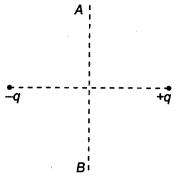
Answer/Explanation
Answer:
Explaination:
The work done is zero, as electrostatic potential at any point in equitorial plane is zero.
65. If the plates of a charged capacitor be suddenly connected to each other by a wire, what will happen?
Answer/Explanation
Answer:
Explaination:
Capacitor will be discharged immediately, and the part of electrical energy will be converted in the form of heat and light (sparks will be produced).
66. Name the physical quantity whose SI unit is F m-1 (farad/metre).
Answer/Explanation
Answer:
Explaination:
Electrical permittivity (\(\varepsilon \text { or } \varepsilon_{0}\)).
67. Where does the energy of a capacitor reside?
Answer/Explanation
Answer:
Explaination: Electrical energy resides in the space, within the plates.